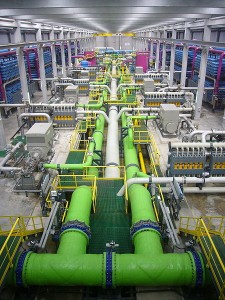
A desalination plant in Barcelona, Spain. CC credit: James Grellier
As a born-and-raised Californian now living in the Midwest, I’ve recently experienced a lot of new things for the first time: toasted ravioli, friendly strangers and, most importantly, seasons. But surprisingly I’ve adjusted faster than I could have predicted, to the point that when it’s constantly raining here in St. Louis and all the greenery is starting to come back to life I forget about the drought that’s currently ravaging my home state. Headlines constantly blare that the state is in crisis, but as visits back to the Golden State haven’t seemed any different, it is easy to forget about from 3,000 miles away. So it wasn’t until Governor Brown’s mandatory water restrictions that the drought moved out of newspapers and into the backyard of my childhood home. But other than attempting to reduce water use (which will most likely be excruciatingly difficult, given water usage per day around the state), what are the options when faced with one of the worst droughts on record?
California’s water shortage is not new, as it has been in effect for the past 4 years. But recently NASA senior water scientist Jay Famiglietti announced that California only has approximately one year of water left in its reservoirs and so despite the vast Pacific Ocean bordering a large percentage of the state, the severe consequences of this drought are looming large. Seawater is readily available but we unfortunately cannot drink it due its high salt content; seawater contains roughly four times the amount of salt in our healthy bodily fluids. If we were to consume that much excess salt, we would rapidly dehydrate ourselves. This would cause a large volume of salt in our system so cells would in turn excrete their water in an attempt to dilute the salt to allow our kidneys to flush it out. Governed by the principle of osmosis, our bodies intuitively attempt to equilibrate the salt content so that it is the same on both sides of the cell membrane. So when we are unable to replenish that fresh water coming out of our cells, our bodies can not function properly. However it would seem that using seawater would be as simple as filtering it (a process known as desalination), so why isn’t that the best option?
Desalination comes with many complications, many of which can be explained with chemical concepts. The first issue starts with the water intake, as it can be difficult to ensure that water is free of larvae, fish eggs, and other tiny organisms. Then once the water has been taken up into the system, a very small filter must be used to remove separate water and salt molecules. To force seawater through this filter, a great deal of pressure is necessary, which in turn means that a large amount of electricity is needed to generate said pressure. At this point the finish line is in sight, but unfortunately one of the larger problems occurs after filtration, when seawater with an increased level of salt is left over from filtration. It would seem likely that this type of brine could be poured straight back into the ocean, but here we have to remember a basic chemistry concept: density. One of the reasons destinations such as the Great Salt Lake and the Dead Sea are popular is because they have a significantly higher density than other bodies of water, so it’s much easier to float in the water. Thus when mixed with regular seawater, the higher density of the generated brine causes it to drop to the bottom of the ocean floor, which can be deadly for many organisms.
So unfortunately, desalination is not quite as simple as filtering seawater, though it is a potential option to help provide for California residents and its large agricultural industry. But given the cost (monetary and resource-wise), it is certainly not the best option.
